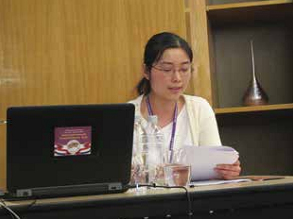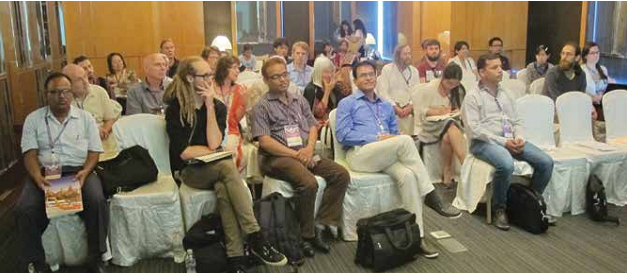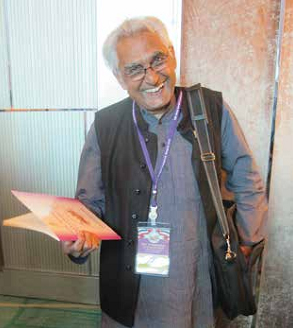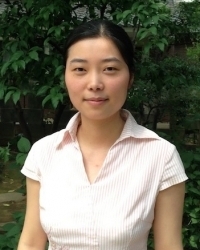
Centre of Jaina Studies Newsletter: SOAS - University of London
The 16th World Sanskrit Conference was held in Bangkok, Thailand, from 28 June to 2 July 2015 under the joint auspices of the International Association of Sanskrit Studies and the Sanskrit Studies Centre, Silpakorn University in Bangkok. More than 600 participants from all over the world attended this mega academic event. The conference was organized in twenty-four theme-based sections and eight independent panels, where scholars in Sanskrit and related fields presented their research on a wide range of topics. The Jaina Studies section, co-organized by Professor Nalini Balbir (University of Sorbonne Nouvelle), who was unfortunately unable to attend, and by Dr. Peter Flügel (SOAS), was held in the morning of the fourth day (1 July) of the conference. It comprised two sessions, and altogether eleven papers were read on various subjects related to Jainism. In addition, there were four papers dealing with Jaina topics read in other sections. The following is a brief report on all these papers.
The first session, chaired by Peter Flügel, consisted of five papers. Ana Bajelj (The Van Leer Jerusalem Institute, Israel) presented "Kundakunda on the modal modification of omniscient jīvas." She explored the ontological nature of omniscience (kevala-jñāna) as the perfect mode (paryāya) of consciousness (cetana) in several works of the Digambara thinker Kundakunda, focusing on the question of whether the consciousness of an omniscient one (kevalin) continues to modally change or not. She pointed out that since a perfectly manifested quality (guṇa) can be neither surpassed nor diminished, one might deduce that omniscience is a state rather than a process. "Such a deduction would, however," as she went on to stress, "contradict and, thereby, compromise Kundakunda's general ontological descriptions of the dynamics of all substances (dravya) as being characterized by a coordinated relationship between permanence and change." In order to find an alternative model of modal dynamics for omniscience, she drew parallels between the nature of modal change in omniscience and the nature of modal change in several other substances (particularly inanimate immaterial substances such as space [ākāśa], time [kāla], etc.). After such comparisons, she concluded that in line with the (probably deliberately) ambiguous ontological statements on omniscience made by Kundakunda, "if omniscience is to be dynamic with a plurality of perfect modes, its dynamics will most likely be unique."

Ayako Yagi-Hohara (Osaka University)
Andrew Ollett (Harvard University) spoke on "Pādalipta and history of Prakrit literature," discussing how Pādalipta (ca. 1st3rd cent. CE) challenges some of the dichotomies that have previously shaped our understanding of the history of Prakrit literature. He argued, "Pādalipta is one of the missing links between the popular and the courtly, between sectarian traditions of storytelling and a nonsectarian practice of literature, and between a pragmatic vernacular and a refined literary language." Given his special status, Pādalipta "allows us to look at the social and historical contexts in which kāvya/kavva took shape." Ollett also argued that while Pādalipta has been remembered chiefly as a "Jaina Prakrit" author, his works in fact represent a literary culture crossing sectarian boundaries and may therefore help us "sketch out a history of Prakrit that is not 'always already' bifurcated into Jaina and non-Jaina traditions".
Ayako Yagi-Hohara's (Osaka University) paper, "On the meaning of AMg allīṇa, pallīṇa," probed into the etymology of allīṇa and pallīṇa/palīṇa used in Śvetāmbara canonical texts, for instance, in the Dasaveyāliya 8.40 where the compound allīṇa-palīṇagutta is used to compare a monk with restrained sense organs to a tortoise. She observed that while some modern scholars associate both words with the root √vlī ("to crush"), ancient commentators explain them as coming from prefix + √lī (to resort to). Based on a survey of the usages of prefix + √vlī or √lī in Sanskrit and Pāli texts, as well as the usages of allīṇa and pallīṇa in Jaina texts, she suggested that allīṇa and pallīṇa are derived from ā√lī and pra√lī, both of which mean "to resort to, to cling" in Jaina texts, thus agreeing with the explanation given in the commentaries.

Juan Wu (University of Leiden)
In her paper, "On the meaning of saṃbhoga in early Jainism and Buddhism," Haiyan Hu-von Hinüber (University of Freiburg) investigated the technical meaning of the word saṃbhoga in early Jainism and its influence on the Buddhist terminology. She observed that both Buddhists and Jainas used saṃbhoga (lit. "eating together") to refer to an "alms district" in which the supplies given by laities were jointly shared by the monks belonging to a certain "saṃbhoga group." In examining saṃbhoga in Jainism, she focused on sources including inscriptions from Mathurā, commentaries by Śāntyācārya and Devendra (11th century), Malayagiri's (12th century) commentary on the Oha-nijjutti, and the triple function of a maṇḍalī (circle) annotated by Siddhasena (5th century). In examining saṃbhoga in Buddhism, she looked into examples found in the Vinaya texts of the Theravādins, the Dharmaguptakas, the Mūlasarvāstivādins, and in the Shanjianlü-piposha (a Chinese version of the Samantapāsādikā). Based on a comparison of Buddhist and Jaina sources, she concluded: first, the Buddhist term saṃbhoga corresponds to the same Jaina term both in its basic meaning as well as in the wording and syntax of legal formulations in which it is used; second, the Buddhists use much more the negative form of saṃbhoga, namely asaṃbhoga as a punishment for guilty monks, novices or laities who have committed a serious misdeed such as denying Buddha's teaching or damaging the unity of the Buddhists monastic community.
In "Parallel stories in the Āvaśyaka commentaries and the Mūlasarvāstivāda Vinaya," Juan Wu (Leiden University) compared stories of three characters (Prince Abhaya, the lay physician Jīvaka and King Udrāyaṇa) in the Mūlasarvāstivāda Vinaya with their counterparts in the Āvaśyaka commentaries. She demonstrated that it is worthwhile not only to identify parallel plots or motifs shared between Buddhists and Jainas so as to appreciate their common narrative lore, but also to examine the different ways in which the two religions handled parallel narrative material in order to distinguish their didactic priorities. With regard to Jīvaka, who is widely known among Buddhists as a model of both medical skillfulness and religious faith, Wu argued that the fact that Jīvaka is prominently featured in Buddhist literature but finds no parallel in Jaina literature may be explained by the different attitudes of the two religions to medical healing and to the role of secular physicians in general.
Eva de Clercq (Ghent University) had originally been scheduled to speak about "Jaina narratives on animal sacrifice," but was unfortunately unable to come to Bangkok.
The second session, chaired by Peter Flügel and Royce Wiles (Nan Tien Institute, Australia), consisted of six papers. The first paper was presented by Kornelius Krümpelmann (SOAS), titled "Johannes Klatt's JainaOnomasticon and the state of research on Jainism at the end of the 19th century." The Jaina-Onomasticon is an encyclopaedic magnum opus written in English by the German Indologist Johannes Klatt (1852-1908). In this awe-inspiring work Klatt gives an extensive list of proper names of Jaina authors, texts, gacchas, places, etc., adding to each entry relevant biographical and bibliographical notes. The original handwritten manuscript, comprising 4,132 pages, is preserved at the Asien-Afrika-Institut in Hamburg. A print-edition is now under preparation at the Center of Jaina Studies, SOAS. Krümpelmann offered an overview of the content and structure of the JainaOnomasticon, and discussed the important position of Klatt's work in the field of Jaina Studies in the 19th century.
Flügel's paper, "Jaina prosopography,"demonstrated the great value of a prosopographical approach for the socio-historical study of collective biography of the Jainas. According to his definition, "prosopography is a research tool for studying patterns of relationships influencing historical processes, based on the systematic collection and analysis of statistically relevant quantities of biographical data about a well-defined group of individuals." Flügel introduced to the audience an informative prosopographical coding scheme built on three sets of collective biographical material, including his self-produced bio-bibliographical database on the Sthānakavāsī mendicants, the data collected by Johannes Klatt in the Jaina-Onomasticon, and a demographic database of the Terāpanth published by Muni Navaratnamal (1981-2002). While introducing the scheme, Flügel explained in detail how biographical data were gathered, the descriptive statistics so far established, and their future prospects.
In "Is the lost Praśnavyākaraṇa a Digambara text? Justification with its language and contents," Jagat Ram Bhattacharyya (Visva-Bharati University, India) suggested that the version of the Praśnavyākaraṇa recently found in the National Archives of Nepal belongs to the Digambara sect.[1] His arguments were as follows: first, "the language of the whole text is in Śaurasenī like other major texts of Digambara tradition"; second, Jīvabhogin, a disciple of the 5thcentury Digambara ācārya Pūjyapāda Devanandin, wrote a commentary on the Praśnavyākaraṇa; third, "the original Praśnavyākaraṇa which is known to be lost has partly survived in other canonical texts," and the surviving references in those texts do not entirely agree with the newly found Praśnavyākaraṇa. In fact, before Bhattacharyya, Diwakar Acharya (2007: 6) also spoke of the probability of the Digambara affiliation of the new text of the Praśnavyākaraṇa.
In "Concealing meaning in inferential statements: The practice of patra in Jainism", Marie-Hélène Gorisse (Ghent University) examined patra, "an inferential statement expressed in an encoded form," and its relevance in Jaina philosophy. In this original way of expressing a reasoning, sentences are formulated in the form of riddles whose elucidation requires, for example, knowledge of lists found in grammatical and epistemological treatises. Gorisse began by introducing the definition of patra given by Vidyānanda (10th century CE) and Prabhācandra (980-1065), and then looked at two examples of patra, namely, the patra "aiming to prove the Jain theory of manifoldness" and the patra "aiming to establish Naiyāyika's conception of Īśvara as a creator of the world." After classifying encoding techniques used in some Jaina philosophical texts, she concluded that displaying a reasoning in a form requiring such a preliminary analysis is a good way both to train the participants in a debate to develop skills required for becoming a good debater (since accessing the meaning of a patra presupposes familiarity with relevant corpora), and to train the debaters to consider a plurality of perspectives from which a statement can be disambiguated, in accordance with Jaina perspectivism.
Royce Wiles (Nan Tien Institute, Australia) presented "From palm leaf to unicode: The relationships between modern editions of Śvetāmbara canonical texts and the manuscript traditions." He introduced systematically the publications of editions of Śvetāmbara canonical texts from the late-19th century till today, with particular attention to "their sources, the interrelationships between those editions, and the nature of the manuscript versions (on palm leaf and on paper) standing behind them." Using concrete examples drawn from the Nirayāvaliyāsuyakkhandha and the Uttarajjhayaṇa, he provided the audience with a clearer picture of the intricate relationships between the manuscripts, the historical printed editions and current electronic versions of Śvetāmbara canonical texts.
The second session had originally included a paper by Jain Phool Chand (B.L. Institute of Indology, India) who was unable to attend. At the last minute Sanusri Bhattacharya (B.Z.S.M. Mahavidyapith, India) took Chand's place and gave a talk on "The Jain Vision and the Future of Humanity."
In addition to the Jaina Studies section, four papers in other sections also related to Jainism. In "Divyadhvani between Jaina, Buddhist and Brahmanical epistemology", Johannes Bronkhorst (University of Lausanne) investigated the reason why some Digambara authors proposed the notion of divine sound (divyadhvani) that is by nature a monotone to refer to the medium through which a Jina teaches.[2] Through considering the intellectual contexts in which these authors worked and lived, Bronkhorst argued that the notion of divine sound represents a radical solution adopted by certain Jaina thinkers to tackle the problem of the "incapacity for language to convey the highest truth." He moreover argued that this problem was perhaps initially introduced by Buddhists (or more precisely, by those Buddhists who developed the dharma-theory in northwestern India during the final centuries before the common era, which "admitted the existence of ultimate constituents of reality called dharmas, but not of the commonsense objects that are composed of these and that fill our daily lives"), and that the same problem later received attention from Jaina and Brahmanical thinkers as well.

In "Jainism and Yoga," Christopher Chapple (Loyola Marymount University) surveyed the primary systems of Jaina yoga as expressed by Haribhadra Virahāṅka (ca. 6th century), Haribhadra Yākinī-putra (8th century), Hemacandra (11th century), Śubhacandra (11th century), Yaśovijaya (17th century), and Ācārya Mahāprajña (20th century).[3] In particular, he observed that Haribhadra Virahāṅka's Yogabindu explains Jaina yoga as a fivefold path of purification traversed by the pathgoer (cāritrin), which differs significantly from the eightfold path set forth by Patañjali in his Yoga Sūtra (ca. 200 CE). Chapple argued that this fivefold path "assumes familiarity with Umāsvāti's fourteenfold path and makes references to subtle nuances within the guṇasthānas that are not known widely outside Jainism." He also discussed in some detail Haribhadra Yākinῑ-putra's eightfold Jaina yoga "as an example of Jaina interaction with the Buddhist, Hindu, and Tantric traditions of Yoga".
In "Summarising or adaptating the Great Epic? An analysis of Mahābhārata epitomes from the 11th-12th Centuries," Christine Chojnacki (University of Lyon 3) examined three summaries of the Mahābhārata, namely Kṣemendra's Bālabhārata (ca. 8,000 verses), Devaprabhasūri's Pāṇḍavacarita (ca. 6,000 verses) and Amaracandrasūri's Bālabhārata (ca. 5,500 verses), focusing on the question of "which motivations urged poets from different religious backgrounds to compose such works in various places of India."
Raval Rishikesh (G.D. Modi College of Arts, India) presented his paper, "A comparative study of Valmiki Rāmāyaṇa and Jain Rāmāyaṇa," looking at several Jaina retellings of the Rāmāyaṇa composed in different historical periods.
In sum, the five-day conference provided a sensational opportunity for Sanskrit scholars from various countries and with different specialties to meet and communicate research ideas. Nalini Balbir and Peter Flügel deserve special thanks for organizing the Jaina Studies section which proved to be a productive, stimulating and enjoyable experience for all attendees. We look forward to a continued vibrancy of Jaina scholarship in the 17th World Sanskrit conference to be held in Vancouver in 2018.
Juan Wu graduated from Peking University (MA, 2008) and obtained her PhD from Cardiff University in 2012 with a dissertation on Indian Buddhist narratives of Ajātaśatru. After completing a two-year research fellowship at University of Tokyo, she is now a postdoctoral fellow at Leiden University, working on a project titled "Royals across religious boundaries: A comparative study of stories of shared royal personages in Indian Buddhism and Jainism" funded by the Robert H. N. Ho Family Foundation administrated by American Council of Learned Societies.

Jayandra Soni, General Secretary of the International Association of
Sanskrit Studies (IASS)
Diwakar Acharya, "The Original Paṇhavāyaraṇa / Praśnavyākaraṇa Discovered," International Journal of Jaina Studies (Online), Vol. 3, No. 6 (2007) 1-10.
Bronkhorst's paper has been published in Sanmati: Essays Felicitating Professor Hampa Nagarajaiah on the Occasion of His 80th Birthday, edited by Luitgard Soni and Jayandra Soni, Bengaluru: Sapna Book House, 2015, pp. 83-96.
 Dr. Juan Wu
Dr. Juan Wu